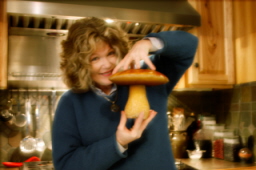
Practice, practice- Ciabatta recipe
My mission has been to get large, glossy holes in a bread like the wonderful examples I have been admiring. I achieved some degree of success with the NYT no knead recipe this weekend. I followed the recipe faithfully and even used the floured cotton towel technique. The soft dough stuck to the cotton, but not too badly. There was no problem with the bread sticking to the dutch oven. It pulled away from the sides as it baked. I did leave it in the oven long enough to scorch the bottom a bit in an attempt to get a deeper brown top crust.

Dutch Oven loaf

Dutch Oven crumb
I used grocery store bread flour this baking as opposed to the high gluten flour and added vital gluten I have been baking with.
I tested my simple ciabatta recipe once again flavored with extra unrefreshed starter. I consider this a yeast recipe rather than a hybrid because the old starter I used had very little leavening potential but a super flavor. Again it yielded a tasty batch with a slightly more open crumb than last week's baking. Maybe my folding is improving!

Simple Ciabatta- 2
The recipe is as follows-
Simple Ciabatta- INGREDIENTS-- For Sponge
- 1/8 teaspoon active dry yeast
- 2 tablespoons warm water (110 degrees F/45 degrees C)
- 3/8 cup of old starter at room temperature
- 2 tablespoons warm water
- 1 scant cup bread flour
- For Bread
- 1/2 teaspoon active dry yeast
- 2 tablespoons warm milk (110 degrees F/45 degrees C)
- 2/3 cup warm water
- 1 tablespoon olive oil
- 2 cups bread flour
- 1 1/2 teaspoons salt
- To Make Sponge: In a small bowl stir together 1/8 teaspoon of the yeast and the 2T warm water and let stand 5 minutes, or until creamy. In a bowl stir together yeast mixture, 2T water, 3/8 cup starter and 1scant cup of the bread flour. Stir 4 minutes, then cover bowl with plastic wrap. Let sponge stand at cool room temperature for at least 12 hours and up to 1 day.
- To Make Bread: In a small bowl stir together yeast and milk and let stand 5 minutes, or until creamy. In bowl of a standing electric mixer fitted with dough hook blend together milk mixture, sponge, water, oil, and flour at low speed until flour is just moistened; add salt and mix until smooth and elastic, about 8 minutes. Scrape dough into an oiled bowl and cover with plastic wrap.
- Let dough rise at room temperature until doubled in bulk, about 1 1/2 hours. (Dough will be sticky and full of air bubbles.) Turn dough out onto a well-floured work surface and cut in half. Transfer each half to a parchment sheet and form into an irregular oval about 9 inches long. Dimple loaves with floured fingers and dust tops with flour. Cover loaves with a dampened kitchen towel. Let loaves rise at room temperature until almost doubled in bulk, 1 1/2 to 2 hours.
- At least 45 minutes before baking ciabatta, put a baking stone on oven rack in lowest position in oven and preheat oven to 425-450 F (220 degrees C).
- Transfer 1 loaf on its parchment to a rimless baking sheet with a long side of loaf parallel to far edge of baking sheet. Line up far edge of baking sheet with far edge of stone or tiles, and tilt baking sheet to slide loaf with parchment onto back half of stone or tiles. Transfer remaining loaf to front half of stone in a similar manner. Bake ciabatta loaves 20 minutes, or until pale golden. Cool loaves on a wire rack.


Comments
Redivyfarm.
Very nice crumb up above. That's another interesting approach to using some old starter. The very white color of the crumb must be helped along by the milk and olive oil, similar to the burger buns.
Bill
Thanks for the kind comments. And how about those burger buns? Every picture you post inspires me to give it a try!
If you use corn starch in stead of flour on your towel the dough won't stick, as starch doesn't absorb the moisture as quickly as flour.
Bart
Cornstarch - great idea Bart, thanks for the tip.
Thanks so much! That is the first time I've seen that suggestion and I will certainly give it a try next baking. I've been very nervous about losing a batch in the final proofs due to sticking. I see mention of non-stick cloth elsewhere but I'm slow to getting around to purchasing the fabulous products that are out there.
Great job, redivyfarm, you're honing your skills, that NK bread looks great!